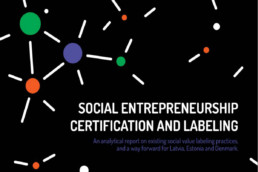5 questions to ask before setting up a social enterprise labeling initiative

This material is based on the report „Social Entrepreneurship Certification and Labeling“ (2017) which provides an analysis of existing social value labeling practices, and considers a way forward for Latvia, Estonia and Denmark. The following presentation summarizes practical insights from the report in a structured manner.
The authors (whose contact details can be found at the end of the document) hope that this material will be useful for all stakeholders dedicated to social enterprise development. It is definitely worth considering certification and labeling as one way to create more favourable conditions for the growth of the sector.
While the following discussion concentrates on labeling, it is important to note that developing criteria to certify social enterprises nationally may also be useful even without creating a label. For example, if a country does not have legal status for social enterprises, a registry issuing certificates to those enterprises fulfilling certain criteria may be a good solution to distinguish social enterprises from other types of organisations. Such a registry would allow for local authorities to consider certified organisations when procuring social value.
Any stakeholder who is inspired by labeling as a powerful communication tool needs also to consider at least five additional questions. The greatest risk of establishing a label would be wasting the time and energy of grass-roots level change makers. The biggest benefit, however, would be contributing directly to their success in earning sales income and creating social value. The assortment of answers to strategically important questions provides a more robust basis for making a strategic decision about whether setting up a label would likely be worth the investment and risks.
STEP 1. Choosing the objectives that the label would help to achieve
Social enterprise labeling may bring a number of benefits. A list of various options is presented on the following mindmap.
Before starting to develop a label, it is important to ask:
· Which of these objectives do we intend to achieve with the help of a label?
· Why do we need a label to achieve those objectives? What could be viable alternatives?
During the process of developing an operational strategy for creating a label, it is useful to return regularly to these initial answers and check whether the way the label is going to be set up is still in accordance with the initial objectives.
The main motivation for establishing the label could also be related to potential benefits that may seem indirect at first glance. For example – after launching the label it may be possible to tie additional activities to the labeling process by activating the social enterprises that have been labeled. Such activities may include joint initiatives for acquiring raw materials and supplies, and coordination to fulfil larger orders from business-to-business clients.
After establishing clear objectives for creating the label, there are a number of other choices to be made. The most important of them are presented on the following mindmaps.
STEP 2. Choosing what to label
The answer to the question „What should be labelled by a social enterprise label? “is not always straightforward.
On the one hand, existing labels from other thematic fields demonstrate the variety of practices. The label could be given to organisations or only to individual products. A label for products may want to reflect superiority over alternatives or instead give no guarantee about their quality.
On the other hand, the diversity of the social enterprise sector also poses challenges. The initiators of any social enterprise label need to find a balance between being specific enough (without ending up in an overly small niche) and inclusive enough (while keeping the criteria and thus, message to stakeholders clear).
STEP 3. Choosing the customer segments who we hope will buy more products and services from social enterprises thanks to our wonderful label
The primary objective of a social enterprise label does not need to be about increasing the sales revenue of the sector. However, when considering the amount of resources needed to establish and run any such process, it does not make much sense to have a label for enterprises that does not support their core activity, i.e. the sales of goods and services.
Firstly, there have to be choices about the sectors from which customers may originate. Would the label be used by public institutions in their tender criteria? Or would it mainly be used to target private consumers? After making such decisions, the segmentation needs to get even narrower. If we have chosen to target – for example – private consumers, then the next questions would be about their age, income, consumption habits etc.
STEP 4. Choosing how to run and finance the labeling scheme
Some practicalities ultimately decide the fate of the labeling scheme. The organisational set-up and the budget should be in accordance with the objectives and the nature of the label.
It is important to realise that establishing a new national label does not need to be a default option. There are a number of viable international choices available, including those operated by Social Enterprise Mark CIC (Social Enterprise Mark) and B Lab (B Corporation certificate). The clear advantage of choosing an existing label is the luxury of concentrating on promotion and marketing from the very beginning of the process. The resource-intensive process of setting up original criteria and establishing a branding concept can be skipped.
However, it all depends on the needs of local social enterprises and the objectives for establishing the label. For example, the inclusive process of setting up unique national criteria for social enterprises may have great value in itself to activate the sector. Independence in making all the decisions related to promotion and development of the label may give the leaders essential flexibility (in order to be nationally successful) that the international schemes may not be able to provide.
STEP 5. Predicting and mitigating risks related to social enterprise labeling
Every big opportunity also entails big risks. The worst case scenario for a social enterprise label would be initiating an expensive failure that manages to drain enterprise resources while convincing the public that social entrepreneurs are insincere opportunists who produce products of low quality. The planning process must take into account all typical risks related to labeling.
The authors welcome questions from international stakeholders who are willing to exchange experience or explore cross-border cooperation opportunities.
Contacts:
Estonia: Jaan Aps, Estonian Social Enterprise Network,
Denmark: Per Bach, Social Entrepreneurs in Denmark,
Latvia: Madara Ūlande, Social Entrepreneurship Association of Latvia,
This publication has been produced with financial support from the Nordic Council of Ministers. The content of this publication is the sole responsibility of the coordinators of this project and does not necessarily reflect the views or policies of the Nordic Council of Ministers.














